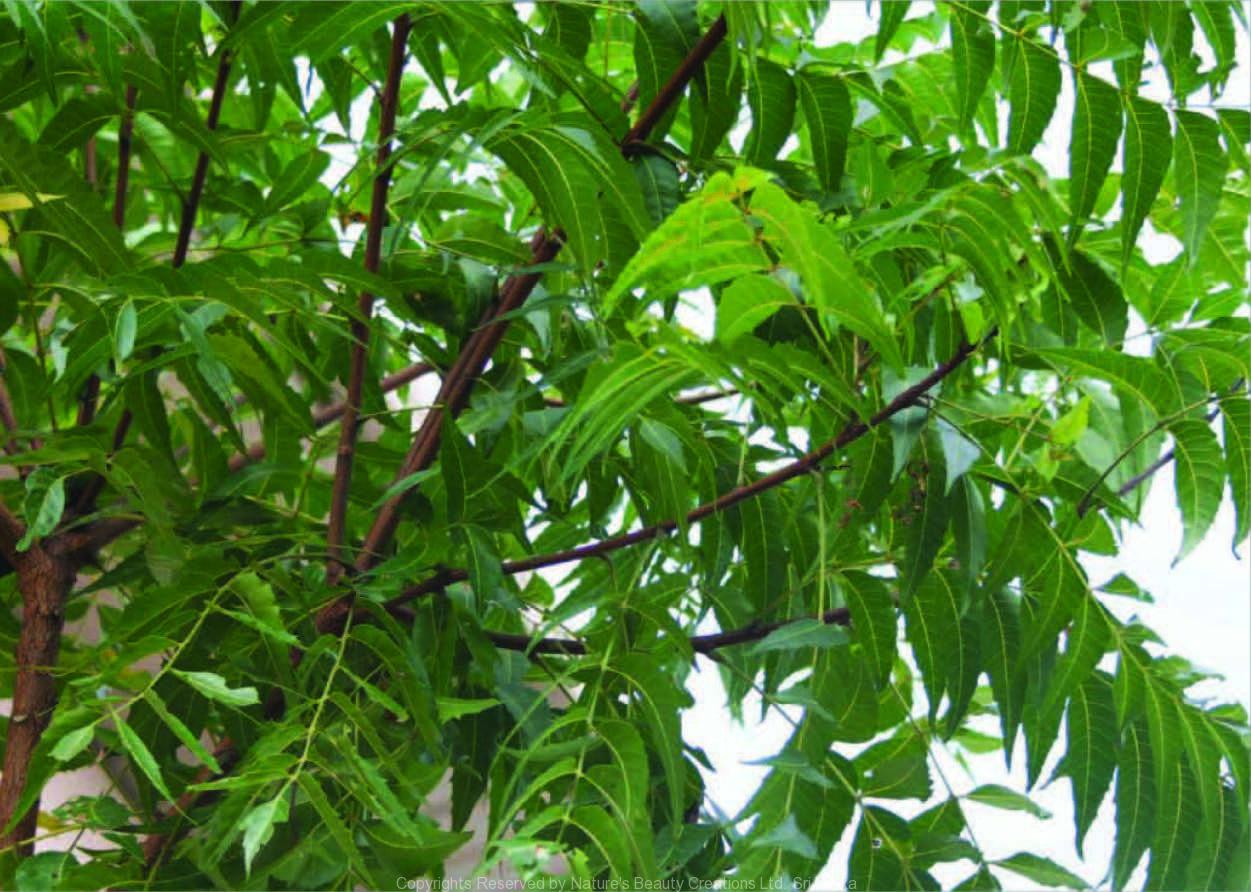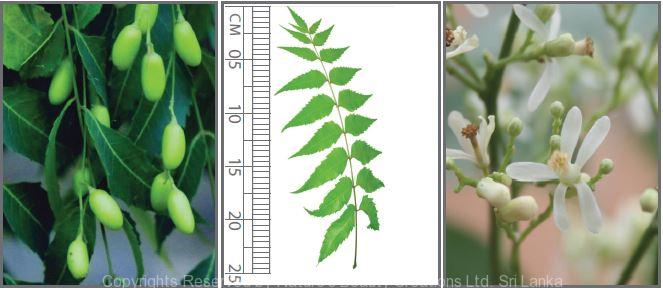

Traditional Knowledge
Useful plant parts :
Leaf, seed, gum and root
Uses in traditional medicine :
- Seed oil is applied on chronic skin diseases
- Decoction of the leaves is used to wash ulcers
- Fresh young leaf juice is taken to get rid of intestinal worms
- Leaves are used as an antiseptic in treating chickenpox
- Gum is used to treat jaundice, skin diseases and catarrh
- Root is used to treat typhoid fever
Scientific Research
Chemical constituents:
Tetranortriterpenes: meliacinolin, nimbin, nimbidin, gedunin, diterpenes: sugiol, nimbiol, limonoids: margosinolide, isomargosinolide, azadiradione, limocin E, nimolicinol, azadirachtin, vepaol from leaves, twigs, bark and seeds; substituted aromatic ester: nimbocetin from fruits; flavonoids: quercetin, kaempferol and their derivatives from leaves
Bioactivity :
Alcohol extract of leaves: anti-inflammatory, peripheral analgesic, antipyretic, antimicrobial, hepatoprotective; leaf extract and seed oil: hypoglycaemic; gedunin: antimalarial; seed oil: active against dental plaque forming microbes; meliacinolin: α-glucosidase and α-amylase inhibitor; some limohoids: anticancer
Clinical:
References : Akhila, A. and Rani, K., (1999), Chemistry of the neem tree (Azadirachta indica A. Juss.), Fortschr Chem Org Naturst, 78, 47-149. Akihisa, T. et al., (2009), Melanogenesis inhibitory, anti-inflammatory, and chemopreventive effects of limonoids from the seeds of Azadirachta indicia A. Juss. (neem), J Oleo Sci, 58(11), 581-94. Alves, P. D. et al., (2009), Chromatographic evaluation and antimicrobial activity of Neem, (Azadirachta indica A. Juss., Meliaceae) leaves hydroalcoholic extracts, Brazilian Journal of Pharmacognosy, 19(2B), 510-515. Anyaehie, U. B., (2009), Medicinal properties of fractionated acetone/water neem [Azadirachta indica] leaf extract from Nigeria: a review, Niger J Physiol Sci, 24(2), 157-9. Chattopadhyay, R. R., (2003), Possible mechanism of hepatoprotective activity of Azadirachta indica leaf extract: Part II, Journal of Ethnophar- macology, 89(2-3), 217-219. Chattopadhyay, R. R. and Bandyopadhyay, M., (2005), Possible mechanism of hepatoprotective activity of Azadirachta indica leaf extract against paracetamol-induced hepatic damage in rats: Part III, Indian J Pharmacol, 37, 184-5. Das, B. K. et al., (1999), Neem (Azadirachta indica) extract as an antibacterial agent against fish pathogenic bacteria, Indian Journal of Experimental Biology, 37(11), 1097-100. Elavarasu, S. et al., (2012), Evaluation of anti-plaque microbial activity of Azadirachta indica (neem oil) in vitro: A pilot study, J Pharm Bioallied Sci, 4(2), 394-6. Khalid, S. A., (1989), Isolation and characterization of an antimalarial agent of the neem tree Azadzrachta indica, Journal of Natural Products, 52(5), 922-927. Khosla, P. et al., (2000), A study of hypoglycaemic effects of Azadirachta indica (Neem) in normaland alloxan diabetic rabbits, Indian Journal of Physiology and Pharmacology, 44(1), 69-74. Kikuchi, T. et al., (2011), Cytotoxic and apoptosis-inducing activities of limonoids from the seeds of Azadirachta indica (neem)., J Nat Prod, 74(4), 866-70. Koona, S. and Budida, S., (2011), Antibacterial Potential of the Extracts of the Leaves of Azadirachta indica Linn., Notulae Scientia Biologicae, 3(1), 65-69. Mordue, A. J. et al., (1998), Actions of Azadirachtin, a Plant Allelochemi- cal, against Insects, Journal of Pesticide Science, 54, 277-284. Nat, J. M. V. et al., (1991), Ethnopharmacognostical survey of Azadirachita indica A. Juss (Meliaceae), Journal of Ethnopharmacology, 35, l-24. Paul, R. et al., (2011), Anticancer biology of Azadirachta indica L (neem): a mini review, Cancer Biol Ther, 12(6), 467-76. Perez-Gutierrez, R. M. and Damian-Guzman, M., (2012), Meliacinolin: a potent α-glucosidase and α-amylase inhibitor isolated from Azadirachta indica leaves and in vivo antidiabetic property in streptozotocin- nicotinamide-induced type 2 diabetes in mice, Biol Pharm Bull, 35(9), 1516-24. Pillai, N. R. et al., (1984), Some pharmacological actions of ‘nimbidin’- a bitter principle of Azadirachta indica-A juss (neem), Anc Sci Life, 4(2), 88-95. Priyadarsini, R. V. et al., (2010), The neem limonoids azadirachtin and nimbolide induce cell cycle arrest and mitochondria-mediated apoptosis in human cervical cancer (HeLa) cells, Free Radic Res, 44(6), 624-34. Schmahl, G. et al., (2010), The efficacy of neem seed extracts (Tre-san, MiteStop on a broad spectrum of pests and parasites, Parasitol Res, 107(2), 261-9. Siddiqui, S. et al., (1986), Margosinolide and isomargosinolide, two new tetranortriterpenoids from Azaurrachta inidica a, juss (meliaceae), Tetrahedron, 42(17), 4849-4856. Subapriya, R. and Nagini, S., (2005), Medicinal properties of neem leaves: a review., Curr Med Chem Anticancer Agents, 5(2), 149-6. Zaman, M. M. U. et al., (2009), Studies on Anti-inflammatory, Antinoci- ceptive and Antipyretic Activities of Ethanol Extract of Azadirachta indica Leaves, Bangladesh Journal of Scientific & Industrial Research, 44(2), 199-206.
Copyrights Reserved By
Natures Beauty Creations




